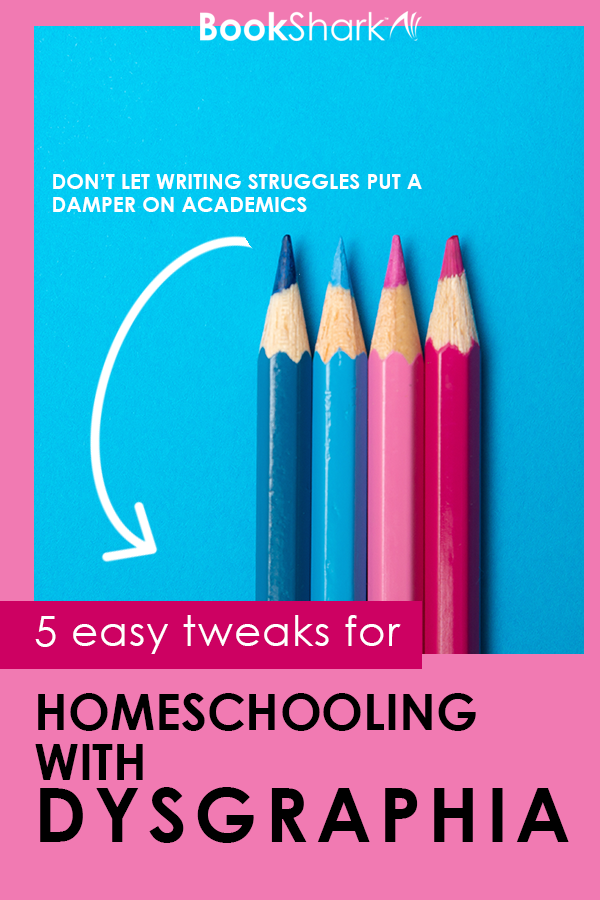




5 Tweaks for Homeschooling with Dysgraphia

In our family, the struggle to read has not been the only challenge our literature-based homeschool has faced. A very close second is difficulty with writing.
Dyslexia and dysgraphia have some overlapping challenges; both make language-based learning an uphill battle. But while dyslexia’s struggles are mostly reading-related, dysgraphia’s struggles are mostly writing-related:
- difficulty with spelling
- trouble organizing thoughts into written sentences and paragraphs
- challenges with the physical act of writing
We’ve had our share of all of these over the years. Nearly all styles of homeschooling require writing of some kind. But how do you teach what’s necessary when your child has trouble with writing or even completing worksheets? Here are five simple but powerful tweaks that you can make for your child with dysgraphia. They remove the bulk of the challenge of writing so that kids can better focus on the academic topic at hand.
1. Complete the Work Orally
We do a lot of our work out loud. For most of the elementary years, my kids narrate (orally retell) what they have read in every subject. Even in middle school, my daughter and I have book chats rather than completing literature worksheets. We cover the same material, and I’ll often ask the same questions as a literature worksheet has asked. But the questions are answered out loud, on the couch, over a cup of tea.
Writing begins in the mind, organizing our thoughts before they ever become words on a page. And for those who tend to be more extroverted anyway, talking outloud is a natural way to organize what we are thinking.
2. Serve as a Scribe for Your Child
After a long period of time of narrating out loud to me, my kids then go through a stage where I write down what they verbally express. Trying to hold a thought and write it at the same time can be particularly challenging for a child who has a language-based disability.
By writing down what my child is saying, I’m modeling the next step of the process without adding extra mental work.
Scribing is not just something we do in writing class, though.

- I’ve scribed sections of a long math page when the process of writing the answers was more overwhelming than the math computation itself.
- I’ve scribed spelling, as my child told me what letter to put down next.
- We’ve scribed phonics worksheets and grammar lessons.
Whenever I felt the skill we were learning was more important than the physical act of writing, I picked up the pencil instead of handing it to my child.
3. Use a Dry Erase Board
I stumbled upon this quite by accident, and I don’t even remember how it happened. But one day I realized my daughter was willingly writing her own original paragraph on a large dry erase board with a marker, something she would never have been able to attempt on a piece of paper.
For awhile, a smaller dry erase board helped her complete her math problems as well. She could write as large as she needed and color-code the columns of numbers to help her line up the correct place values. Once again, she was focused on the academic skills without the added complication of writing small enough to fit the space in a workbook.
4. Don’t Fill Out Worksheets
Instead of writing on a worksheet which can cause frustration due to the tiny spaces, use it merely as a guide for writing on another medium.
For example, my youngest also has a very hard time writing the size that his worksheets require. His handwriting ability lags behind his phonemic awareness. But there’s no need to let his handwriting hold him back in his reading lessons!
Rather than mark vowels or divide syllables within the narrow spaces of a worksheet, I copy the words from his worksheet onto individual index cards, as large as the card allows. My son easily works through each word card, marking vowels and circling phonograms, and then happily feeds the completed cards to his tissue-box monster we’d made together.
He was focused on the reading skills he was ready to master but no longer discouraged by his weaker writing skills.
5. Use Technology
My kids learn typing skills early on. It’s my sneaky way of enforcing letter recognition, spelling, and reading. But typing has also helped my kids to progress with writing skills without being discouraged with spelling, grammar, and handwriting.
When it’s time to write, I always allow automated spell check and other assistive technology. Dyslexia Aid is another favorite that allows my child to dictate a phrase or sentence into the app and see it translated into text. For my family, it’s a matter of deciding which skill or combination of skills we are prioritizing, rather than insisting on all the skills at once.
It’s kind of ironic that we have chosen a literature-based homeschool with our assortment of language-based disabilities, but it’s not a decision I’ve ever doubted or regretted. Our challenges have not kept us from either enjoying good books or having deep thoughts about those books. We’ve simply changed our tools and strategies for success—and sometimes our expectations.
But in the end, that’s the life lesson I want my children to take with them. No personal difficulty has to signal the end of something we value; we simply have to find a solution that rises to the challenge.

About the Author
Tracy Glockle lives with her husband in Oregon where she homeschools their crew of three kids with ADHD/dyslexia. She’s constantly making adjustments for her out-of-the-box learners, finding creative ways to use their strengths to teach their weaknesses. As the frontal lobe for her family of ADHDers, Tracy loves planners and systems and organization. But housecleaning—that’s something else entirely. She enjoys black coffee, superhero action films, and reading the end of a story first. Tracy writes about homeschooling ADHD and dyslexia for several blogs including her own at Growing In Grace.
